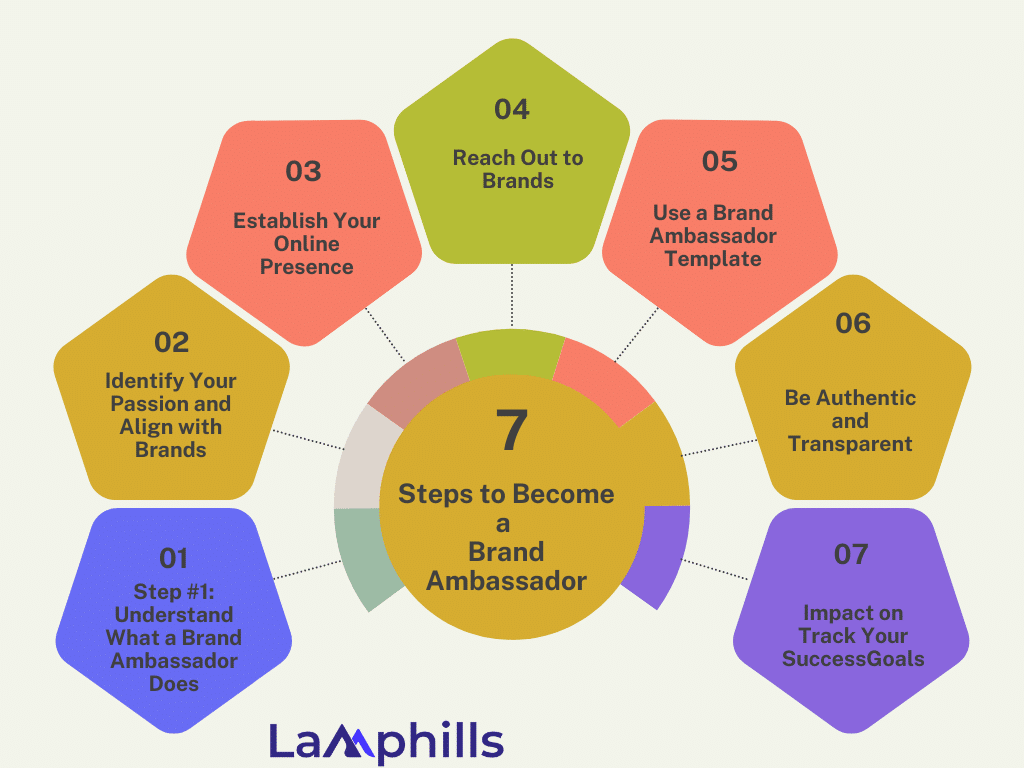When I first heard about the concept of brand ambassadors, I assumed it was only for celebrities and influencers with large audiences. However, I quickly realized that ordinary individuals, like you and me, can also become successful brand ambassadors. My transition from regular consumer to representing brands I adore has been really satisfying. In this article, I’ll reveal a straightforward strategy for becoming a brand ambassador, supported by statistics and insights that you won’t find elsewhere. Whether you are an expert in any sector or just starting out, this article will help you navigate the path of becoming a brand ambassador.
What Does It Mean To Be a Brand Ambassador?
A brand ambassador is someone who represents a corporation in some capacity. Several corporations now invest in brand ambassador programs. Companies use these marketing initiatives to hire influencers to serve as the “faces” of their brands and promote their products to a specific audience.
A brand ambassador’s primary responsibility is to promote a brand’s products. For example, brand ambassadors recruited by fashion brands may post photos of themselves wearing the designer’s goods or a video of themselves opening their clothing haul. Similarly, a brand ambassador for a beauty company may market their makeup goods by providing video instruction for their followers.
Because brand ambassadors are committed to a few firms that share their beliefs, they must also be well-versed about the items they represent. Online brand ambassadors use this knowledge to teach audiences through channels such as TikTok LIVEs, Instagram Q&As, and other online marketing events (which are typically paid for by the brand).
Being a brand ambassador is an excellent opportunity to earn money while supporting a line of products or services that you genuinely value and want to see increase in popularity.
Key Takeaways
- Brand ambassadors promote officially partnered brands while really appreciating and utilizing the products themselves.
- Follower count is not a barrier to entry: passion and skill in your field make you an ideal potential brand ambassador.
- You can be compensated for your material right away: brand ambassador programs may offer commission payments or other non-monetary incentives, such as free products and insider access.
- You’ll work on long-term collaborations, gaining a better understanding of the brand’s product and developing your content over time.
- The advantages of being a brand ambassador include recurring collaborations, developing partnerships with brands, extending your content portfolio, and earning money from your content.
How Much are Brand Ambassadors Paid?
Because they are heavily involved in product education and promotion, brand ambassadors are typically compensated through commission-based affiliate networks. For larger events, they may also be paid per appearance or event. Similarly, brand ambassadors can be compensated based on the sort of social media posts, the length of the material, and the amount of brand mentions.
There is no limit on how much a creator can earn. For example, MrBeast is one of the top earners in the space, earning a staggering $54 million per year as a YouTube creator. Other top content makers have made millions by podcasting, capturing their lives on TikTok, and recording highly fascinating experiments.
More practically, it will be tough for a smaller content creator to become a millionaire only through sponsored content. If you’re trying to figure out how much to charge as a brand ambassador, Hootsuite advises a basic guideline of $100 per 10,000 followers, plus additional costs based on content requirements.
Steps to Become a Brand Ambassador

Step #1: Understand What a Brand Ambassador Does
Before we get started, it’s important to understand the job of a brand ambassador. Brand ambassadors are people who represent and promote a company’s products or services, usually through their own social media platforms or personal networks. According to a Nielsen survey, 92% of customers trust recommendations from individuals above brands, demonstrating the importance of personal endorsement.
A brand ambassador represents the brand’s values and promotes them authentically to their target audience.
Step #2: Identify Your Passion and Align with Brands
Begin by determining the items or services you are most enthusiastic about. Authenticity is essential in brand ambassadorship. Choose brands that reflect your hobbies and values. For example, if you are interested in fitness, look at health and wellness brands.
To identify and align with brands, start by listing your hobbies and interests.
- Research Brands: Look for brands that share these interests.
- Check Brand Values: Ensure that the brand’s values are consistent with your own.
I enjoy eco-friendly products, so I looked for firms that value sustainability. This connection made it simple for me to sincerely recommend their items.
Step #3: Establish Your Online Presence
Maintaining a solid internet presence is vital. This doesn’t mean you need millions of followers; engagement and sincerity are more important.
To establish an online presence, follow these steps: – Create quality content that aligns with your hobbies and the brands you want to promote.
- Interact with Your Audience: Respond to comments, ask questions, and form a community.
- Consistent blogging: Stick to a regular blogging schedule to keep your audience engaged.
According to Influencer Marketing Hub, micro-influencers (1,000 to 100,000 followers) engage at a 60% higher rate than macro-influencers.
Step #4: Reach Out to Brands
Don’t wait for brands to contact you. Proactively contact the companies you want to represent. Create a persuasive pitch that explains why you’d be an excellent brand ambassador.
Steps to Reach Out:
- Research Contact Information: Identify the appropriate contact person, typically in the marketing or PR department.
- Craft Your Pitch: Explain your enthusiasm for the brand, your target audience demographics, and how you intend to market their products.
- Showcase Your Value: Provide engagement statistics and previous examples of successful promotions.
When I contacted a skincare brand, I expressed my interest in natural beauty products and supplied interaction numbers from my skincare-related Instagram posts.
Step #5: Use a Brand Ambassador Template
Using a Brand Ambassador Template can help you streamline your approach and make sure you cover all of the important aspects in your pitch. This template helped me arrange my ideas and deliver a professional pitch to potential brands.
Are you ready to become a brand ambassador and take your personal brand to the next level? Download our comprehensive Brand Ambassador Template now to start crafting compelling proposals and connecting with your favorite brands
Step #6: Be Authentic and Transparent
Authenticity and transparency are critical. Your audience can tell if you’re not truly enthusiastic about the things you’re pushing. According to Stackla, 86% of consumers prioritize authenticity when picking which brands to enjoy and support.
Tips for Authentic Promotion:
- Use the Products: Share your personal experiences with the products.
- Be Honest: If there are parts you dislike, be candid but constructive.
- Keep Trust: Transparency fosters trust in your audience, making your advice more effective.
Step #7: Track Your Success
Monitor the success of your brand ambassador initiatives to demonstrate the value you provide. Use analytics to track engagement, reach, and conversions.
To track success, use analytics platforms such as Instagram Insights, Google Analytics, and brand-provided tools.
- Set Goals: Define success for yourself and track progress toward it.
- Report Back: Share these stats with the brands you represent to show your influence.
I used Instagram Insights to track the success of my posts and provided monthly reports to the brands with which I worked. This enabled me to establish long-term partnerships.
How to Be a Brand Ambassador for In-Person Events
Attending brand events in person might provide a great opportunity to become a brand ambassador. Here are the actions to take:
Step #1: Researching Local Brands
Find local brand events using online platforms such as Facebook and search engines. Consider your interests and passions when you filter down the companies you want to represent.
Step #2: Prepare Yourself
You must have an engaging online presence, particularly on social media channels related to your expertise. Additionally, building skills such as good communication and interpersonal ability is essential. To stand out, focus on a certain area of interest or competence.
Step #3: Reaching Out To Company Representatives
Contact event organizers or company representatives to inquire about being a brand ambassador. Show excitement and knowledge about the organization to boost your chances of being recruited.
Step #4: Apply for the Position
Check the company’s website or job search sites for any open brand ambassador roles. When applying, provide any relevant marketing or hospitality experience. If you are chosen as a brand ambassador, your responsibilities may include product demonstrations, sample distribution, and event setup.
Tips to Increase Your Impact as a Brand Ambassador
To maximize your impact as a brand ambassador, consider the following suggestions:
- Encourage your followers to ask questions and share their experiences with the products or services you recommend. Respond to comments and interact with your audience to establish a deep relationship.
- Increase your reach by providing high-quality content and engaging with other successful influencers in your field. Consider making your profile public to get more attention.
- Compensation as a brand ambassador can take several forms, including cash or free items. Examine contract terms carefully to verify they are consistent with your goals and values.
What Skills Are Needed to Become a Brand Ambassador?
To be a great brand ambassador, important abilities include good communication, social media competency, creativity in creating interesting visual content, and a thorough understanding of the brand.
Is Being a Brand Ambassador a Job?
Yes, brand ambassadorship is considered a profession. It entails representing and marketing a brand to improve its image and reach a larger audience. Brand ambassadors often participate in a variety of activities to raise awareness and foster good associations with the brand.
Why and How Do Creators Pick Brand Ambassador Roles?
Let’s take a look at how brand ambassador programs could be the appropriate next step for you—but you should also be aware of the potential drawbacks.
Benefits of brand ambassador programs
- Getting paid for creating content (for perhaps the first time).
- Building long-term ties with brands
- Increasing your creator portfolio for future prospects.
- Meet other brands and creators through events.
- Getting special discounts or free stuff
Cons of Brand Ambassador Programs
- Limiting the number of brands you can work with.
- Connecting your reputation as a creator to a brand
- Getting entrenched in programs with poor rewards and incentives
What Other Benefits Might a Brand Ambassador Receive?
A brand ambassador may request the following in addition to monetary compensation:
- Content exclusivity
- Invitations for events
- Product Incentives
Brand ambassadors receive a variety of incentives, which vary based on the industry or brand with which they work. Do not be scared to ask for what you want; it may be the only way to acquire it.
Conclusion
Becoming a brand ambassador needs passion, devotion, and sincerity. By following this easy method, you can go from being a typical consumer to a trusted spokesperson for the products you care about. Have you considered becoming a brand ambassador? What measures have you taken to get started? Let’s continue the conversation in the comments section.
Related Articles
- Brand Crisis Management: 7 Tested Tips
- The Ultimate Guide To Ambassador Marketing In 2024
- How Much Do Social Media Influencers Make? Income Breakdown
- Different Types of Influencers And How To Determine Which One You Need
- 10 Most Resounding Influencer Marketing Fails in History (Lessons to Learn)






